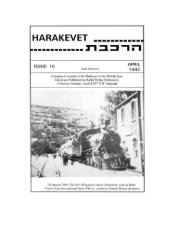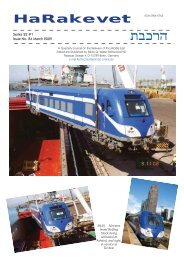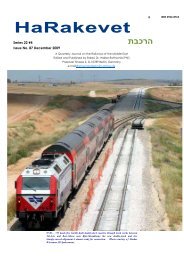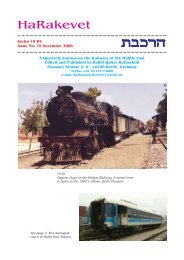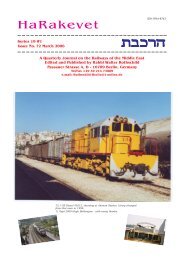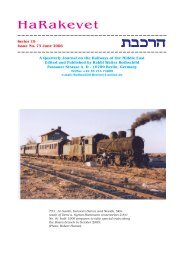You also want an ePaper? Increase the reach of your titles
YUMPU automatically turns print PDFs into web optimized ePapers that Google loves.
the medium future. For the worldwide mobility and<br />
logistic markets climate-friendly transport modes<br />
that also save scarce resources will become part of<br />
the elementary questions for the future. And in this<br />
respect the Railway is the best."<br />
"Can the Project in the Near East open<br />
the door to other large contracts?"<br />
"In the coming two decades investment<br />
in the Arabian Peninsula in construction and<br />
improvement of railways will reach a three-figure<br />
sum in Billions. The DB wants to be involved here<br />
from the outset and to set the standards."<br />
B. DUBAI.<br />
'C.R.J.' No. 160 p. 80: Dubai Metro.<br />
The new fully-automatic light metro system was<br />
scheduled to open on 9th. September 2009. A<br />
visitor on 9th. February (2009) saw one of the 5-car<br />
units being tested on track along Shaikh Zayed<br />
Road. The line will be operated and maintained by<br />
Serco, and the UK Office of Rail Regulation has<br />
signed a memorandum of understanding with the<br />
Dubai Roads and Transport Authority to ensure rail<br />
safety. The Red Line runs parallel to the coast, and<br />
the subsequent 22.5km. Green Line, due to open in<br />
March 2010, will run on both sides of the Dubai<br />
creek. There will be two interchange stations, at<br />
Al-Ittihad (Union) square and at Burjuman. The<br />
main depot is at Rashidiya. Rolling stock will<br />
consist of 64 five-car sets built by Kinki Sharyo in<br />
Japan, with seating for 400 passengers and<br />
standing room for many more. They will provide<br />
standard-class 'Silver' and first-class 'Gold'<br />
accommodation, and have a separate section for<br />
women and children."<br />
C. EGYPT.<br />
(i). CONTROL.<br />
From 'C.R.J.' No. 160 (Winter<br />
2009/10) p. 75.<br />
"In June 2009 the US Trade<br />
& Development Agency awarded a US$ 658,323<br />
grant to Egypt's Ministry of Transport to support<br />
the development of a positive train control (PTC)<br />
system for Egyptian National Railways. PTC<br />
technologies and systems are expected to improve<br />
safety on ENR, and increase the capacity of the network.<br />
At the end of June, GE Transportation<br />
and ENR announced the completion of<br />
commissioning 80 Evolution Series locomotives.<br />
These locos represent a $400M investment over<br />
eight years, and since introduction they have been<br />
successfully hauling freight and passenger trains.<br />
This is ENR's first order for locos with electronic<br />
fuel injection, which has proved to be superior to<br />
mechanical injection and will reduce ENR's fuel<br />
consumption significantly. In addition to being<br />
more fuel-efficient, the locos also generate<br />
significantly lower emissions than the rest of the<br />
fleet."<br />
(ii). ACCIDENT. Marc Stege-mann<br />
sent the following translated from the NS staff<br />
magazine ,De Koppeling' of 22.01.2010: (possible<br />
source: ANP)<br />
Eight״ employees of Egyptian Railways<br />
have been sentenced for causing a serous railway<br />
accident. Near Cairo, a passenger train ran at full<br />
speed into a train which was standing still. Shortly<br />
Page 14<br />
before this accident, the first train had made an<br />
emergency stop after a collision with a buffalo<br />
cow. The driver of this halted train appeared to<br />
have remains of cannabis in his blood. He was<br />
sentenced to the longest term: 7 years<br />
imprisonment. The driver of the passenger train<br />
was sentenced to 3 years imprisonment. The<br />
accident caused 18 casualties."<br />
(iii) . VIDEOS.<br />
In World-Diesel-Loco(a)yahoogroups. com,<br />
Philip Wormald" wrote: A great short video<br />
clip showing the big new ugly but fantastic<br />
sounding GE's on this link<br />
http://www. rail-videos.net/video/view.<br />
php?id=7950 .<br />
To which a Mohamed responded:<br />
"Here are the full videos from dashloc<br />
caught in Egypt."<br />
http://www.youtube.com/<br />
watch?v=qNdWNpxUIOs<br />
http://www.youtube.com/<br />
watch?v=Q4BeYg4QZT8<br />
http://www.youtube.com/<br />
watch?v=8ICv8WsyR7w<br />
[The video clips are fascinating for<br />
myself, as Editor, who has never been to Egypt.<br />
The trains pictured are either roaring through<br />
suburbs or departing and arriving from a major<br />
terminus like Rames; passengers (almost all men)<br />
are hanging in open doorways, casually<br />
disembarking as the train is still weaving its way<br />
over the points, or sitting out at the rear vestibule<br />
over the buffers! Men are walking across the tracks<br />
in all directions as light engines and trains move<br />
constantly about. The rolling stock involves a vast<br />
number of ,Eu-ropean-type' bogie coaches, with<br />
opening doors and windows, and painted in a variety<br />
of liveries - two-tone blue, two-tone blue and<br />
white stripe, clean, ex-works with white roofs,<br />
blue/grey white with a dark-blue wavy stripe on<br />
each side, not symmetrical but if two coaches are<br />
marshalled together the wavy line can continue<br />
(but doesn't always), blue and yellow... and yet<br />
with one exception - a diesel multiple unit with<br />
some coaches in red /black and some in blue - the<br />
sets seem to be consistent. (Do the different<br />
liveries have any specific meaning?) Station pilots<br />
include GM Bo-Bo's and centre-cab bo-Bo's<br />
similar to the IR ,Yo-Yos'. Train locos are GM<br />
Co-Co's (also in a variety of liveries), Modern GM<br />
(Class 66'-type) Co-Co's which are lower than the<br />
stock, Henschel Co-Co's and the<br />
הרכבת<br />
new GE mid-blue Co-Cos, which tower upwards<br />
looking so tall for the track gauge and with almost<br />
a ,Pharaonic' expression on their cab fronts.... ]<br />
D. ERITREA. (From C.R.J. 160, p. 175).<br />
"Motive power for a tour group in<br />
March 2009 comprised Mallets 440.008, 442.55<br />
and 442.59 and 'Littorina' No. 2,<br />
but 442.54 failed before the tour started. On<br />
Sunday 8th. March the weekly tourist train was<br />
seen on its return from Nefasit to Asmara,<br />
composed of 440.008 and a single passenger<br />
carriage, but on the following Sunday it was<br />
cancelled owing to a lack of bookings. The small<br />
shed at Ghinda has been closed, and all locos and<br />
passenger carriages are now based at Asmara.<br />
Serviceable steam locos, in addition<br />
to those listed above, were 0-4-0T 200.002<br />
and, following repair, 442.54; under active repair<br />
were 202.010 and 442.56. Serviceable diesel locos<br />
and railcars were 27D, Drewry 2079, 'Littorina'<br />
No. 2 and 'Ural'<br />
No. 1."<br />
E. SUDAN.<br />
It remains a moot point whether Sudan<br />
truly belongs to the area covered by 'Harakevet',<br />
but owing to the links with Bert Dyke and various<br />
military railway units in the Second World War we<br />
have from time to time mentioned the railways<br />
here. In 'C.R.J.' No. 160 p. 77 (which itself refers to<br />
scant and brief notes in issues 126 and 136) is a<br />
report from this tragic and troubled country, of<br />
April 2009. "No public train timetables were<br />
available, but it was found that there is a weekly<br />
train north from Khartoum to Wadi Halfa,<br />
departing on Monday, arriving on Tuesday<br />
evening, and returning from Wadi Halfa on<br />
Wednesday morning with an arrival at Khartoum<br />
on Thursday evening. Journey time appears to be<br />
about 36 hours. There has been no passenger<br />
service between Atbara and Port Sudan since<br />
approximately 2007.<br />
There is a Khartoum - Atbara service<br />
running nightly, departing at 21.00 and arriving at<br />
06.00, with no sleeping cars or air-conditioning in<br />
the formation. The return journey is at similar<br />
times. Some tracks within Khartoum have been<br />
rerouted recently compared with maps published in<br />
the 1960's, a 2005 map still showing the original<br />
routing.<br />
On the Dafur line, a train runs<br />
fortnightly to Nyala, departing on Sunday and<br />
scheduled to take four days, though it may take up<br />
to seven days each way. It was seen arriving back<br />
in Khartoum on 4th. April, preceded by a security<br />
train of two passenger coaches with an armoured<br />
vehicle on the rear. The public train was formed of<br />
13 vehicles with a generator car at the front. The<br />
train was filled to capacity and powered by two<br />
American-type diesel locos. The outward service<br />
was seen on 12th. April, with approximately 15 ve



